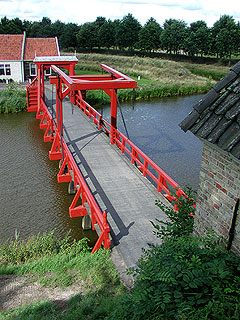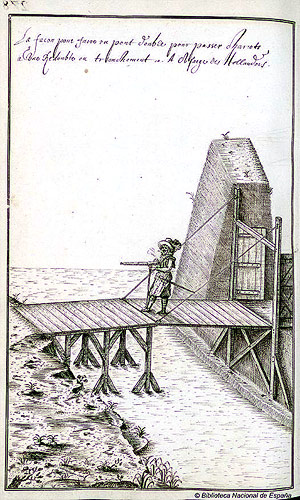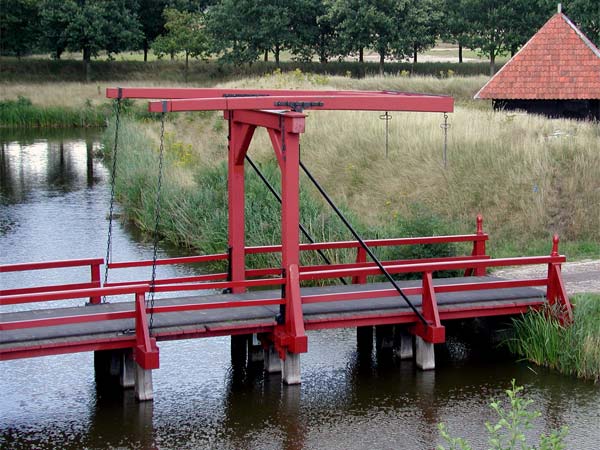 |
Little Drawbridges |
Not only could a ditch or moat impede attackers, it impeded friendly traffic, too. To allow people, animals, wagons and whatnot access to and from the fort's gates, bridges crossed the ditch. To halt unwanted traffic, like marauders, the bridges could be constructed as drawbridges.
One has an image of drawbridges drawn from Hollywood of heavy, bulky platforms of thick wood and raised with great clanking chains to be held upright at the wall - sometimes even forming a formidable gate. By comparison, some drawbridges for artillery forts were almost petite. The concept was not to form a barrier when drawn but simply to provide a causeway when down. Thus, they were made only as strong as required to support traffic going over them. The gap opened in the causeway was not wide, and the updrawn part did not become a towering barrier.
 Three
drawbridges were restored at the fortress of Bourtange in the
eastern Netherlands. They appear almost identical to an
etching of a drawbridge made by Rembrandt, and this style of
drawbridge was also over canals. For canals, the bridge was
drawn up to permit boats to pass through.
Three
drawbridges were restored at the fortress of Bourtange in the
eastern Netherlands. They appear almost identical to an
etching of a drawbridge made by Rembrandt, and this style of
drawbridge was also over canals. For canals, the bridge was
drawn up to permit boats to pass through.
Drawbridges at Bourtange are separate from the gates. They are drawn up by people simply pulling down on chain handles. Nearly all the lifting is provided by a counterweight.
Considering the stoutness and brute strength of the artillery
fort, why were not the drawbridges stout and strong to match?
That was really not necessary. If an artillery fort were
besieged and the besiegers pressed close to a drawbridge, it would
have been easy for the defenders to burn it or blow it away with a
well-aimed cannon shot or two. (And before that point, the bridge
may have already been destroyed in the bombardment.)  After the
siege, not much effort and materials were needed to make a
replacement.
After the
siege, not much effort and materials were needed to make a
replacement.
A few period illustrations of artillery forts suggest they had little drawbridges such as these at Bourtange - or even no drawbridge at all, simply a light bridge. Use of "few" and "suggest" is an advisory because some illustrations appeared to have outright omitted bridges and others sketched them in a "sort-of" way. Without cameras back then, we're at the whim of artistic license. But this casualness may also be interpreted to mean that artists and engineers did not think bridges for forts were a big deal.
To identify the parts of the drawbridge, click here. The large curved arrows to be seen indicate direction of movement when the drawbridge is lifted. Double click that link to return to the original image.

Until a siege entered its final phase, an assault on the bastions and ramparts of the fort, defenders continued to make use of their bridges to deploy soldiers outside the fort's walls, and that was where most of the fighting took place.
| Back |
Dynamic Defense |
|
|
|